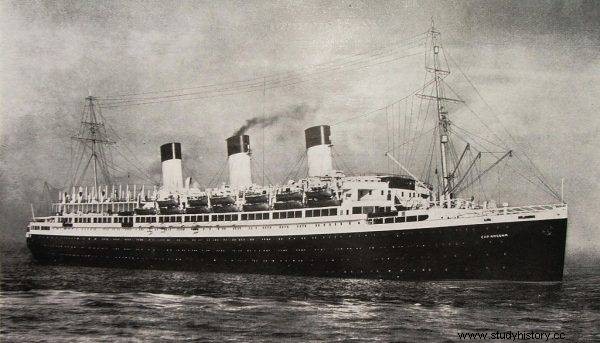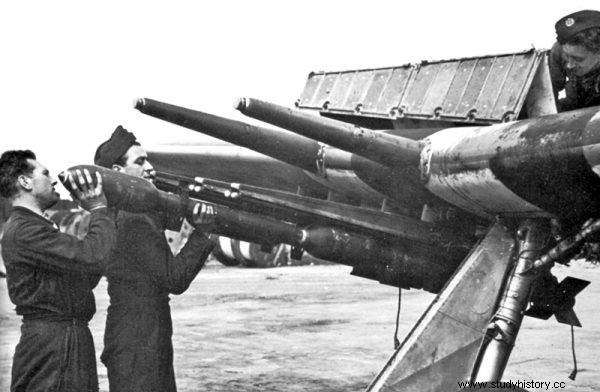"There is a pause between the bombs dropped by leading planes and those that were following them. I got up to look out the window. The train was stationary on the tracks, heading north [...] American pilots had just arrived on a mission to destroy the bridge in Allerona at the moment when we were passing their destination "- recalled Sgt. Richard Morris, one of the American walkers who miraculously survived the allied bombs.
Indeed, those who survived the unfortunate day of January 28, 1944, could speak of great happiness. In view of the withdrawal of Italy from hostilities, many of the Allied prisoners held in the camps there probably hoped to regain freedom soon and see their comrades-in-arms. But neither of them could have expected it to happen under such dire circumstances.
One bridge too many
The railway crossing near the Italian city of Alleron turned out to be the site of one of the largest and most tragic mistakes by the Allied aviation. An unmarked train with nearly a thousand British, American and South African prisoners of war had the misfortune to pass through this crossing north of Rome just as a squadron of 27 US B-26s arrived.
Their task was downright routine, and in view of the weakness of the Luftwaffe, not burdened with any risk - to destroy a strategically important railway link on the Paglia River.
When the bombs from the first wave of planes began to fall into the river valley, the staff stopped the train in the middle of the crossing and escaped. The soldiers guarding the prisoners immediately followed suit, leaving them in locked wagons to your fate.

An unmarked train with nearly a thousand British, American and South African prisoners of war had the misfortune to pass through this crossing north of Rome just as a squadron of 27 American B-26s arrived
At that time, the pilots of the next strike groups, unaware that their bomb targets were "their own" , and seeing the Germans fleeing in all directions, they began to attack the POWs of Echelon with even greater determination and precision. Several hundred tons of bombs fell on the bridge and the wagons within minutes . The effect was overwhelming, because in addition to the destroyed two spans of the bridge, the American pilots could save themselves a direct hit of 10 cars and damage to several dozen more.
The imprisoned prisoners desperately tried to get out of this hell on earth. “It was a terrible sight. We were all locked in cattle cars with only a small window in the top corner, which was entwined with strands of barbed wire, ”recalled another survivor. Bill Marsh.
Fortunately, bomb explosions did not always lead to death. Shock waves of almost half-ton loads broke the roofs and damaged the doors and walls of the cars. It allowed me to escape. Some of the lucky ones who did so ran under a barrage of bombs along the train station to free the rest of their companions from the still intact carriages. Nevertheless, as a result of a friendly bombing and bullets by German guards , about 400 prisoners were killed, and as many were injured . Only a few managed to escape and hide until the arrival of the Allied forces.
Soon, the American pilots heard news about whom their bombs had hit. And one of them wrote in his diary:
[...] our boys caught a German train stopped on the bridge and dropped bombs among the escaping enemy soldiers, only to find out later that some of our prisoners were on the train. January was a tragic and sad period for all of us and it broke our hearts…
No witnesses
However, the train crash in Alleron pales in comparison to the hecatomb of the victims of the "friendly fire" in the Bay of Lübeck in early May 1945. It is all the more tragic as it happened at a time when the Thousand-Year Reich lay in ruins and its Führer had been dead for several days.
Nevertheless, the final chords of the war were for the Nazi torturers a time of obliterating all traces of the crime, the best proof of which were the words of Heinrich Himmler: "No concentration camp prisoner can fall into enemy hands alive" . In carrying out this monstrous order, death factories across Europe were systematically evacuated, driving thousands of exhausted people on death marches to the still-operating camps.

Prisoners of KL Neuengamme near Hamburg
One of them was KL Neuengamme near Hamburg. At the end of April, however, it was not able to accommodate the constantly flowing mass of prisoners. In this situation, and in view of the rapid progress of the Allied forces, the German authorities were forced to take even more radical actions. Once again rising to the heights of his criminal practices in this war, it was decided to ... sink ships filled with prisoners in the waters of the Bay of Lübeck.
In post-war investigations, most witnesses argued that prisoners were to be transported safely to Sweden. Since February, negotiations between the Swedish Red Cross and Himmler on the evacuation of prisoners of Scandinavian origin continued. The Reichsführer considered them harmless and believed that, thanks to his humanitarian attitude, Sweden would be an intermediary in the capitulation talks between Germany and the Western Allies. As a result of safe evacuation, only a few lucky ones survived, while the rest were loaded onto the ships in Neustadt.
The macabre intention to "finally resolve" the issue of inconvenient witnesses was also supported by the fact that the units did not receive Red Cross decals and in most cases were unsuitable for deep-sea travel. Therefore, there were many indications that the Germans either wanted to sink them themselves, or - more likely - they hoped that the Allies would do it for them.
Movie star
The SS Cap Arcona was also among these floating mortals. This passenger liner, launched in 1927, was considered one of the most beautiful in its class in its glory years. Until the outbreak of the war, he managed to travel from Europe to South America over 90 times, transporting over 200,000 people in comfortable conditions. passengers.
Its magnificence and uniqueness was also appreciated by the dynamically developing - despite the war conditions - "Hollywood on the Rhine". In 1942, Cap Arcona was hired for the title role in the propaganda movie "Titanic" . The painting, however, never made it to distribution, and the main character himself slowly began to lose his brilliance in tedious cruises with transports of soldiers and refugees (especially from East Prussia).

The SS Cap Arcona was also among these floating mortals.
In early May 1945, the former movie star was no longer anything like an Atlantic wave killer. Worn-out and unrepaired machines hardly allowed for slow maneuvers, and not so long ago the luxurious passenger cabins presented an image of poverty and despair.
And it was on such floating wreck that over 4.5 thousand people were embarked. exhausted prisoners, including those from Auschwitz and Stutthof . Such a large mass of people by far exceeded the cargo capacity of such a powerful liner, which in normal service was able to accommodate less than half of this number. As a result, the ship was unimaginable tightness. There was a terrible stench of faeces in the air.
The prisoners in the other two units intended for the alleged evacuation were also held in similar conditions. The much smaller than the liner freighter Thielbeck and Athen packed another 5,000 people.
Last Cruise
Meanwhile, according to British intelligence on May 2, the Germans began forming large convoys with their own troops in the waters of the Bay of Lübeck and Kiel, who were to be transferred to Denmark and Norway for further combat. Today it is known that such a massive transfer of forces was not possible then, but the Allies did not seem to know it back then. Therefore, wanting to be safe than sorry, they decided to neutralize these convoys.
Interestingly, on the same day the employees of the International Red Cross informed the British about the real purpose of the ships anchored in Neustadt . However, this message, for unknown reasons, did not reach the higher command. Or perhaps it was ignored because the fear that even only a small group of German commanders would flee was too great.
Initially, however, to preserve the appearance of respect for the laws of war and to limit any unnecessary losses, the Allied command gave the following message in plain text:
We call on all naval vessels flying the flag of the Third Reich to call at port immediately. All German ships encountered at sea after They will be bombed at 14.00 on May 3.
Only the SS Athen commander took advantage of this summons, who, despite the objections of the SS unit on board, hung a white flag and called at Neustadt. In this way, risking his own life, he saved 2,000. prisoners in the holds of his freighter.

From the sky, according to the Allied ultimatum, a real avalanche of bombs and rockets rained down on the floating concentration camps.
However, the passengers of the other two ships were not that lucky. Their commanders, forced by Waffen-SS soldiers to stay in the waters of the bay with the flags of the Third Reich hoisted, could only watch helplessly what happened shortly after 14.
From the sky, according to the Allied ultimatum, a real avalanche of bombs and rockets fell on the floating concentration camps. The immobilized ships were an easy target for English pilots who sank Thielbeck very quickly. Overcrowded to the limit, the freighter pulled almost 3,000 to the bottom. victims. Due to its size, the Nazi Titanic resisted a little longer. But he too had to succumb to the blast of British planes. One hour after the start of the attack, the burned and riddled wreck of Cap Arcona leaned over and landed on the bottom of the bay, shallow in this place.
Any rescue operation was effectively prevented by the SS men present on board, who secured all the lifeboats for themselves in advance and shot at the survivors trying to escape . Pilots also fired on the rescuing prisoners, convinced that they were killing the Germans . On the other hand, those who managed to swim to the shore were mostly murdered by guards, members of the Hitler Youth and the Volkssturm.
Ultimately, with over 4.5 thousand Only 350 prisoners on board Cap Arcona were saved. Soon they also found a safe asylum among the Allied soldiers who took the port of Neustadt just hours after the raid. British authorities forbade anyone to mention the tragic raid of May 3, 1945. However, for a long time it was evidenced by the overturned wreckage of Cap Arcona and the remains of the victims washed ashore for many more years, for whom salvation was so close.
Bibliography
- Kaczmarek R.M., Tragedy in the Bay of Neustadt , "Sea, Ships and Ships", ed. spec. 3/2015.
- Piętka B., The last crime of the Third Reich committed by the Allies , Wprost.pl [access:28/05/2021].
- Galewski T.M., War crimes at sea in World War II , Gdańsk 1976.
- Sergiusz J., The Ships of Death. The last days of Neuengamme , [in:] Five minutes to midnight , ed. A. Kozłowski, Warsaw 1966.
- Cooper S., The Tragedy of the SS Cap Arcona - WWII's Titanic , WarHistoryOnline.com [access:5/27/2021].
